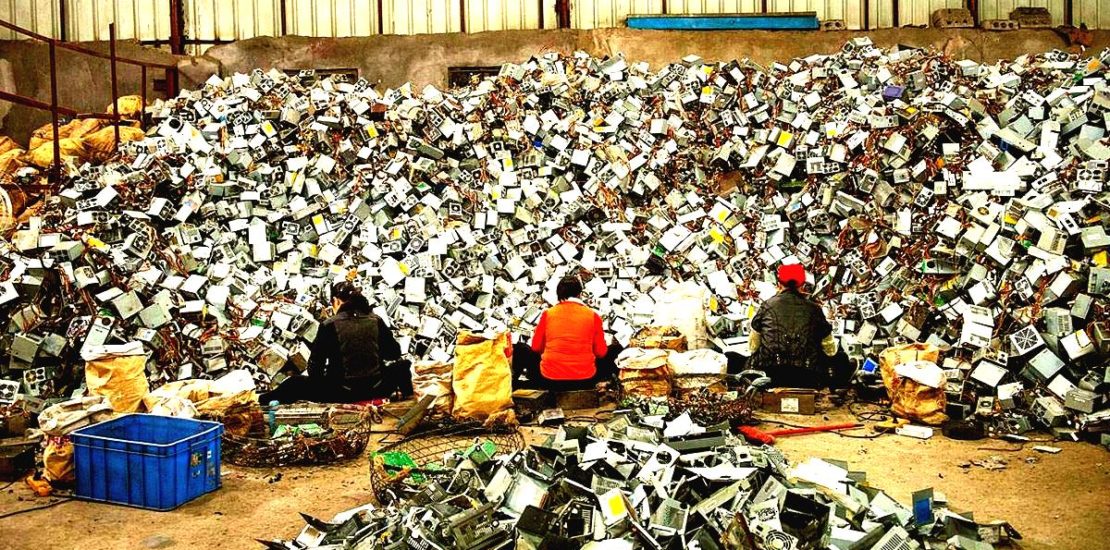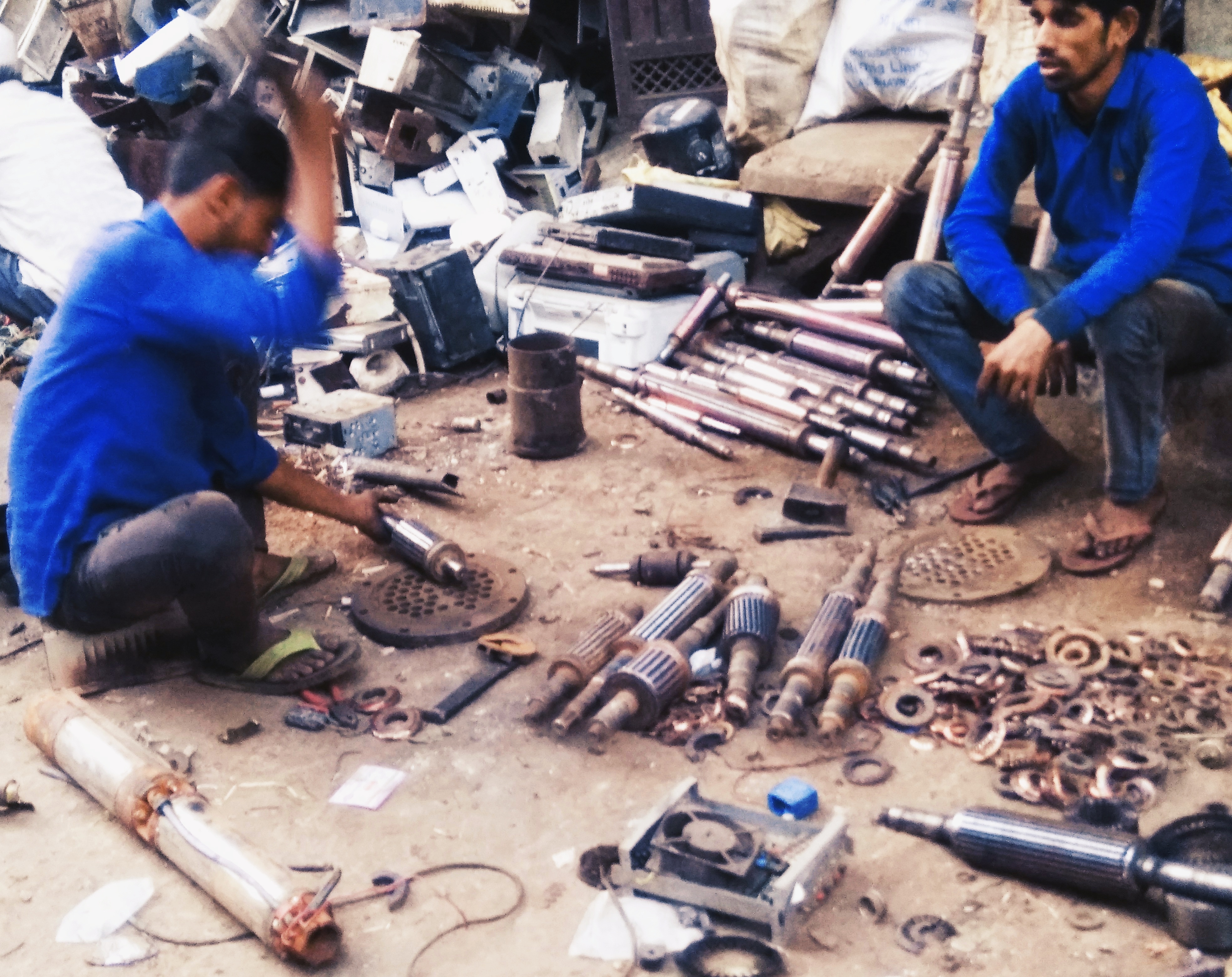- December 13, 2019
- Posted by: Sayam Singh
- Category: ENVIRONMENTAL HEALTH, Featured, HEALTH CARE, Issue Brief, Latest Work

Discarded electronic equipment which is no longer in use is termed as electronic waste or simply E-waste. These may range from gadgets such as mobile phones, laptops, televisions refrigerators, Printed Circuit Boards(PCB) and so on. This waste has a severe impact on health, and thus its management is a cause of immediate concern for concern. The fast-growing sector of technology renders current electrical equipment obsolete at an increased rate, adding to the bulk of the problem.
Within India, the dire problems created by improper e-waste management have not received adequate attention from concerned authorities. It was discovered that India generates 2 million tonnes of e-waste annually (Haran and Solanki n.d.) Though now it has stopped, earlier India imported 50,000 tonnes of e-waste (Mehra 2018). It only serves to complicate the existing plethora of problems as India lacks administrative and infrastructural initiatives to manage e-waste.
The magnitude at which the problem persists and continues to grow is not given adequate attention by policymakers. The limited number of policies framed fall short of exploring the interlink that exists between improper e-waste management, health and poverty within the country. Moreover, they are not effectively enforced. As a result, e-waste management has reached a nadir.
This article identifies areas where current policies aimed to target the problem of waste can improve and suggests necessary steps in that direction. For the purpose of convenience, I will divide recycling of e-waste into three levels – collection, dismantling and disposal; suggesting adequate measures, wherever necessary from both a micro and macro perspective. The purpose of the former division is to outline solutions that ensure a smooth and concise chain of e-waste recycling, while the objective of the latter is to provide a solution that can target the detrimental effects of e-waste generation, at both, individual and national level.
Collection
It was contended that due to lack of knowledge about management, electronic goods that become obsolete lay unattended within households as well as offices across the nation. As a way of management, these goods were either sold off to local scrap vendors or discarded with regular solid waste (Borthakur and Singh 2012). It indicates that enough steps have not been taken to ensure that the public can dispose of e-waste with convenience. If facilities to dispose of e-waste to exist, then the public is either unaware or unwilling to use them. Thus, the first step, in this case, is to improve the collection of e-waste, as in the absence of proper collection practices, e-waste either lies forgotten or gets mixed with regular waste.

Illegal e-waste collection units in the localities of the New Mustafabad area, New Delhi Pic: PCI India
Civic bodies have taken steps to address it. In a bid to manage e-waste, New Delhi Municipal Corporation(NDMC) partnered with a private firm to collect 7 tonnes of e-waste from the city. They outlined a plan to approach Resident Welfare Associations across town to assist them in the collection of their waste (Kaushika 2012). However, while initially successful, the outcome has not been as desired. Plans to approach RWAs across town are yet to materialise. It indicates that the framing of policies is not sufficient. Adequate measures must be taken to ensure that they are enforced. Routine checks can be carried out periodically to ensure that policies are being implemented.
Since the general public did not use designated e-waste bins installed across the city, one plan outlined for the future by the Department of Environment was to rope in consumers and to segregate waste. By taking the help of non-governmental organisations, they were going to train ragpickers and scrap dealers to identify e-waste, which was to be sent to four registered recycling centres in the NCR. (Kaushika 2012).
This is a welcome approach that uses both the formal sector of recycling as well as engages consumers to take responsibility for their waste.
A more pragmatic approach would be to install local centres where residents can dispose of their e-waste. RWAs can work to make residents aware of potential hazards of e-waste and their disposal methods so that they can segregate the wastes and dispose them at nearby collection centres. It is important to rope in the general public not only to ease the burden on government officials but also to teach a culture of responsible citizenship. The reason behind people not using designated e-waste bins must be identified and then a comprehensive solution must be devised to tackle the issue.
The government has also tried to rope in the corporate sector to ensure a smooth collection of e-waste. However, improper implementation has made this only partially successful. For the convenience of electronics makers, including handset companies, the Ministry of Environment and Forests revised erstwhile collection targets. These new targets that were equal to a share of the company’s yearly sales were aimed at easing e-waste recycling for the corporate sector, particularly multinational enterprises.
According to the new rule, companies involved in selling of mobile phones prior to five years or seven years have to ensure that e-waste collected by them should be equal to 10% of the sales done in the financial year five or seven years back, while recent entrants will need to meet lower targets of 5%. This move was seen as beneficial to tech companies particularly Chinese companies like Vivo, who entered the market late. (Aulakh 2018). In addition, the mandated collection targets for new producers who have recently started their sales operations is distinct from others, to benefit those whose sales operations are lower than the average life of their product (Sharma and Hussain 2018). Steps taken by policymakers to address economic concerns deserve appreciation. By easing collection targets the government eased the path for those who generate e-waste to do their part in managing it. However, this is an incomplete solution. Regular supervision by government agencies is required to ensure that the corporate sector is carrying out its responsibility.
An investigation by the committee revealed that out of the 80 centres listed as e-waste collection centres, 20 were not in operation. The responsibility of operating these centres was on the shoulders of multinational tech giants such as Vivo, Samsung, HP, and so on (Patel 2019). This indicates that the government cannot wash their hands from the responsibility of e-waste management by shifting the responsibility onto manufacturers. The two have to work in conjunction with each other. Tasking the producer with a task is a step forward in the right direction, but provisions to ensure that the policy is being properly implemented is also necessary. The collection centres must be routinely checked. The reasons behind corporate companies shrugging away from running collection centres must be identified and resolved. As an additional measure, a small fine must be issued on those who listed fake centres. A penalty may seem too severe a punishment; however, sometimes a firm hand goes a long way. This would ensure that manufacturers work diligently towards e-waste recycling.
Dismantling
Consumers are seldom concerned with what happens to e-waste once they have discarded it (Borthakur and Singh 2012). For the consumer, their responsibility ends with getting rid of e-waste.
Every year, approximately 10,000-25,000 tonnes of e-waste is handled by bare hands (Monika and Kishore 2010). It occurs as this part of the process of e-waste recycling is dominated by the unorganized sector. Approximately 90% of e-waste recycling in India is carried out informally (Girdhar 2019). Workforce engaged in process of dismantling within the recycling sector comprises mostly of the urban poor who, due to low literacy rates, have limited awareness regarding the potential hazards of e-waste(Borthakur and Singh 2012. However, the problem goes beyond the scope of simple awareness. Recycling in India is marred with the poor socio-economic status of its workers, worsening both health and environmental conditions. Limited awareness pertaining to the link between respiratory illnesses and acrid smoke caused by burning of e-waste does exist but workers are apathetic to their own situation or environmental implications (Park 2019).

Most of the dismantling units were operating manually without any occupational health safeguards Pic: PCI India
Thus, instilling awareness would not be enough to improve their conditions. Awareness drives need to be backed with initiatives that provide a platform from where the voice of workers can be heard. Poverty and resulting dependency upon their jobs will render them incapable of fighting for their right to safe working conditions.
Even within this segment, the majority includes women and children, which only serves to exaggerate the ongoing menace (Borthakur and Singh 2012). Thus, the vulnerability of the marginalised sections increases due to the high prevalence of women and children involved in this work. (McAllister, Magee & Hale, 2014).
Park (2019) reported on the appalling conditions that characterised the e-waste dismantling sector in India. He noted that informal e-waste recyclers often termed as ‘kabadiwalahs’ or ‘raddiwallahs’ worked without proper tools such as face masks, gloves or even footwear. Their earnings, dependent upon the quantity and quality of materials they could manage to extract, were quite low. A worker earned between INR 200-800 in a day; women and children were paid even less. Besides, the constant fear of police raids loomed over their heads. The concern led them to prevaricate the journalist’s questions about their conditions.
This demonstrates the extent to which these workers have been alienated by administrative authorities. Not only are they continually exposing themselves to high risks for low pay but under-researched legislation has served to deplore their conditions further and also, distanced them from civic authorities.
Economic inequalities seem to be the least of women’s concerns. It was found that hazardous substances found in e-waste affected women’s endocrine and reproductive functions, increasing the incidence of autoimmune disorders, anaemia, endometriosis, cancers of the reproductive system and so on. Moreover, exposure to substances like lead and mercury affect not only women but hamper fetal development as well (McAllister, Magee & Hale, 2014). Thus, improper e-waste management places both women and the future population of the country at risk. Women become vulnerable due to entrenched structural inequalities, that are manifested in their health status as well.
Immediate action must be taken to preserve the quality of both present and future population. Since improper e-waste management posits a greater risk to women than men, added measures must be taken to protect them. Specific policies aimed at safeguarding women’s health need to be devised immediately.
The segments that can be recycled should be separated by workers in factories under safe conditions. The government must approach this with a three-pronged strategy. At the first stage, the number of organised recycling sectors should increase. The government can partner with NGOs to hold awareness drives to educate the workforce regarding the need to work in a safe and healthy environment. Greene is one such organisation that is sponsored by the government to instil awareness. Generation of awareness, though necessary, is not enough by itself to motivate those whose livelihood depends upon e-waste segregation, and owing to their low socio-economic status are at the mercy of their employers.
The objective of the second stage is to encourage factory owners to ensure that their workers are working in a safe and healthy environment. Efforts must also be made to introduce cost-effective safety gear to encourage owners of dismantling factories to provide the same for their workers. This gear should also allow smooth movement for the convenience of workers. Other methods could be either to engage an ASHA worker or provide factory owners with a coupon that would get them a discount at a local hospital so that regular physiological checks like blood tests of workers can be carried out.
At the third stage, the government should encourage the formation of labour unions. This would allow workers to collectively raise their voice in fighting for their rights. Labour unions would start to develop once the sector gets organised. These labour unions should have both a man and a woman as co-leaders to ensure that concerns of both sexes are equally represented. Measures must be taken to ensure the rapid organisation of this sector. The organisation of this sector would bring it within the purview of civic bodies, which will facilitate both, management of e-waste as well as improvement in the quality of population’s health.
Disposal
The next step is to develop environmentally sustainable methods to dispose of e-waste.
Department of Information Technology has sponsored research focuses on developing environmentally sustainable methods to dispose of e-waste. The objective of this research is to develop recycling technology that deals with different kinds of e-waste in a manner that produces minimal environmental damage and maximum economical profits (Chatterjee n.d.). Thus, the government is moving forward in the direction of forging an integrated approach towards e-waste management; one that takes both, environmental concerns and financial needs into account. Despite this, improvements in ground reality remain to be seen.
Across states, specific areas that are to be dedicated to a particular type of e-waste disposal, like pyrolysis, mechanical or hydrometallurgical technique should be demarcated. Care should be taken that these areas are not near densely populated areas. Provisions should be made to ensure that the segregated e-waste from collection centres is brought to these locations. Additionally, necessary steps must also be taken to ensure that those responsible for carrying out the process are duly protected from the occupational hazards that may be exposed to.
Conclusion
The menace of e-waste requires solutions at both the micro and macro level. Policies framed at the macro-level must not negate the concerns that stem at the micro-level. Additionally, policies must address the triangular relationship that exists between health, environment and e-waste management. These policies should aim to conceive of solutions that simultaneously protect the environment and population health. Policies framed at the macro-level must devise of ways to further damage to the ecosystem as e-waste pollutes water and air which leads to biological and psychological damage, affecting the health of the population as a whole. At the micro-level, appropriate solutions must be framed that take into account the perils that the urban poor and other marginalised sections of society engaged in e-waste management practices have to face. In this manner, a comprehensive strategy aimed to minimise the detrimental effect that e-waste has on health and the environment must be designed. Well-integrated and comprehensive policies that are resolutely enforced must form the crux of the solution
References
Aulakh, G. (2018, April 18). Environment Ministry eases e-waste collection targets for electronics companies. The Economic Times. Retrieved from https://economictimes.indiatimes.com/industry/cons-products/environment-ministry-eases-e-waste-collection-targets-for-electronics-companies/articleshow/63808026.cms?from=mdr&utm_source=contentofinterest&utm_medium=text&utm_campaign=cppst
Chatterjee, S. Electronic Waste and India, Electronic Waste and India (n.d.). Retrieved from https://meity.gov.in/writereaddata/files/EWaste_Sep11_892011.pdf
Girdhar, A. (2019). E-waste import ban will help, but that’s not India’s recycling problem. The Indian Express.
Haran, G., & Solanki, A. (n.d.). (Electronic waste (dissertation). Retrieved from https://www.academia.edu/38801580/Ewaste
Kaushika, P. (2012, August 28). Seven tonnes of e-waste, collected and recycled. Seven Tonnes of e-Waste,Collected and Recycled. Retrieved from https://indianexpress.com/article/cities/delhi/seven-tonnes-of-ewaste-collected-and-recycled/
Kishore, J., & Monika. (2010). E-Waste management: As a challenge to public health in India. Indian Journal of Community Medicine, 35(3), 382–385. doi: 10.4103/0970-0218.69251
McAllister, L., Magee, A., & Hale, B. (2014). Women, E-Waste, and Technological Solutions to Climate Change. Health And Human Rights, 16(1).
Mehra, P. (2019). ‘The urgency to tackle e-waste is showing on the ground’. The Hindu – Business Line.
Park, M. (2019). Electronic waste is recycled in appalling conditions in India. The Conversation.
Patel, S. (2019, September 11). Big tech firms had e-waste centres but only on paper, many addresses fake: Delhi probe. The Indian Express. Retrieved from https://indianexpress.com/article/india/tech-firms-e-waste-centres-addresses-fake-delhi-probe-5981091/
Sharma, R., & Hussain, S. (2018, April 26). E-Waste Management In India – Environment – India. Retrieved from http://www.mondaq.com/india/x/695996/Waste Management/EWaste Management In India.
Thakur, A., & Singh, P. (2012). Electronic waste in India: Problems and policies. INTERNATIONAL JOURNAL OF ENVIRONMENTAL SCIENCES, 3(1). Retrieved from https://www.academia.edu/4470207/Ewaste_article
https://www.hhrjournal.org/2014/07/women-e-waste-and-technological-solutions-to-climate-change/
https://www.ncbi.nlm.nih.gov/pmc/articles/PMC2796756/#CIT2

